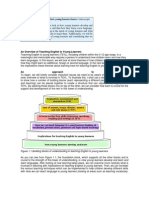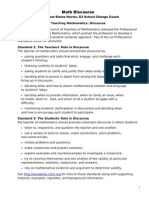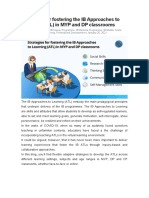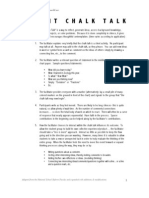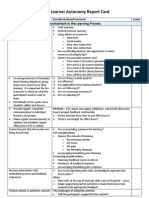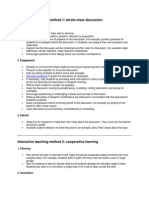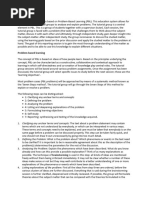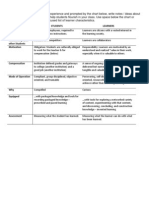Brainstorming - A Planning Guide
Brainstorming - A Planning Guide
Uploaded by
Ilene Dawn AlexanderCopyright:
Available Formats
Brainstorming - A Planning Guide
Brainstorming - A Planning Guide
Uploaded by
Ilene Dawn AlexanderCopyright
Available Formats
Share this document
Did you find this document useful?
Is this content inappropriate?
Copyright:
Available Formats
Brainstorming - A Planning Guide
Brainstorming - A Planning Guide
Uploaded by
Ilene Dawn AlexanderCopyright:
Available Formats
Brainstorming
Brainstorming is a strategy used to generate a number of ideas to help solve a
particular problem. The technique has been around for over 70 years and is still
used today to engage students in solving a range of problems.
Brainstorming is a
cooperative approach in
which a number of people
collectively agree upon a
solution after all of their
ideas are brought forth
and discussed.
Techniques vary but there is a general structure to follow when developing
brainstorming sessions. After the problem or issue is presented, students are
organized into groups to brainstorm all possible ideas which could solve the
problem. Discussion of these ideas takes place after the brainstorming session
ends, usually after a defined period of time. Each idea will be discussed and
considered, some ideas will be eliminated, and a final list will be ranked for
possible use as a solution toward solving the problem.
It is important to plan the brainstorming session before implementing it in the
classroom. As outlined below, you will need to consider the strengths, challenges
and barriers when designing the session.
Planning a Brainstorming Session
Provide students with the
problem/topic that is new
to them and one that
challenges their current
level of knowledge on the
issue.
Stress that all ideas are
welcome and even ideas
which are perceived as
out there, funny or
silly, or weird can
lead to creative solutions.
1. State the problem or issue.
a. Avoid preparing students by giving them the problem or issueyou
dont want them to think about the topic beforehand. Brainstorming
sessions are meant to be spontaneous and creative. Provide students
with the problem/topic that is new to them and one that challenges
their current level of knowledge on the issue.
b. State the problem/topic as a question which is concise and to the
point. State the problem/topic succinctly yet loose enough to
encourage more idea generation. A stated problem which is too
succinct may be difficult to understand and one which is too limiting
may restrict creative ideas.
c. Use sample question stems(adapted from Elkenberry, 2007):
i. In what ways might we improve product X?
ii. What are the characteristics of X?
iii. What is it about X that sets it apart from other Xs?
iv. How can we do A and B?
2. Identify the roles of all students in the group.
a. Often one student acts as the group facilitator who records all
generated ideas, encourages participation, prevents negative remarks,
and watches the time.
b. All other group members are to be collaborative, respectful, and
cooperative.
3. Explain the guidelines of the brainstorming session (the DOs and DONTs).
a. Stress that all ideas are welcome and even ideas which are perceived
as out there, funny or silly, or weird can lead to creative
solutions.
Northern Illinois University, Faculty Development and Instructional Design Center
facdev@niu.edu, www.niu.edu/facdev, 815.753.0595
BRAINSTORMING
Page | 2
b. During the session there is to be no criticism or evaluation of ideas
which could inhibit contributions.
c. Encourage the group to relax and be enthusiastic about the process.
d. Encourage use of items such as squish balls, pipe cleaners, and other
gadgets to create a relaxed environment.
e. Everyone must participate, even those students who tend not to
contribute in class discussions. All voices are to be heard and
everyone must contribute ideas.
f. No one student can dominate the brainstorming session by shouting
over the others or contributing meaningless solutions.
g. Encourage students to not delve on one idea for too long.
Ideally, more people in a
group can lead to more
ideas being generated.
4. Keep the group number group manageable (8-12 people works well).
a. Generally, more people in a group can lead to more ideas being
generated. However, it may be difficult manage large groups in a
classroom setting. Experiment to see what works well in your own
courses.
b. Too many people could intimidate those who tend not to participate
from offering their ideas.
5. Create a relaxed environment which is supplied with adequate workspace
and materials and free from distractions.
a. Provide necessary tables, chairs, paper and writing instruments,
white board and markers, flip chart, or concept mapping software
such as Inspiration or SMART Ideas.
b. Provide background music (unless students find it distracting).
c. Ask students to refrain from annoying mannerisms such as leg
swinging, gum chewing, and pen twirling which can interfere with
other students concentration.
d. Announce that all cell phones and electronic devices be turned off.
Groups should consist of
students who vary in
experiences, backgrounds,
knowledge and academic
disciplines.
6. Create heterogenic groups. Groups should consist of students who vary in
experiences, backgrounds, knowledge and academic disciplines.
a. A varied group of students will suggest more varied and unique ideas
and suggestions.
7. Rank the generated ideas and suggestions. After the designated time frame is
over, students should begin to evaluate and rank all of the ideas generated
during the brainstorming session. Suggest that students create a list of criteria
used to evaluate the ideas. They should work toward a final list of three to
five highly possible solutions to the problem. Criteria should be given scores,
with 5 being a perfect score to 0 which would indicate that the idea does not
meet any of the criteria.
a. Sticky notes are helpful and can be moved when chunking and
categorizing ideas.
b. Criteria also can be established before the actual brainstorming
begins.
8. Review the brainstorming session. It is important to provide some form of
follow-up to the brainstorming session as a sort of follow-through to support
Northern Illinois University, Faculty Development and Instructional Design Center
facdev@niu.edu, www.niu.edu/facdev, 815.753.0595
BRAINSTORMING
It is important to provide
some form of follow-up to
the brainstorming session
as a sort of follow-through
to support student effort.
Brainstorming sessions
allow individual students
voices to become one with
the groups voice.
Explain that as part of this
course all students are
expected to bend a little
which may have them
participating in activities
which might make them
uncomfortable.
Page | 3
student effort. Even if their suggested solutions are not used, its good
practice to provide feedback. Thanking the students for their efforts will
prove to them that their work is valued, and encourage them to participate in
a future brainstorming activity. The final report should include the following
elements (adapted from Baumgartner, 2005):
a. Statement of the original problem or issue
b. Criteria and scale used to evaluate the brainstorming ideas
c. All ideas generated during the brainstorming session
d. Criteria and rating scales used to evaluate the generated ideas
e. Final rated items and their scores
f. Relevant comments and further ideas provided by students during the
rating process
g. How final rated items are used (provide feedback with explanation if
the final rated items are not used)
Strengths of Brainstorming
Provides a quick and easy class activity. Brainstorming sessions can be
effectively used in the classroom. However, they do require meaningful
planning time for ultimate success.
Contributes to classroom collective power. Brainstorming sessions allow
individual students voices to become one with the groups voice. The final
ideas are generally identified through consensus.
Creates a student-centered activity. Students direct the group in which they
generate their own ideas, develop rating criteria, and are responsible for
group dynamics.
Supports learning in a relaxed environment. Students are able to collaborate
in a relaxed, informal learning environment.
Strengthens problem-based learning. Brainstorming is a problem-solving
activity where students build on or develop higher order thinking skills.
Encourages creative thought. Brainstorming encourages students to think
creatively (out of the box), encouraging all students to share their ideas, no
matter how far out there they may seem.
Challenges of Brainstorming
Keeping the session from being just a chat session. The moderator should
direct the session to keep students on task.
Ensuring students collaborate rather than compete with one another when
generating ideas. Walk around the room and listen for inappropriate group
behavior.
Encouraging students to build on each others ideas to help them build their
critical thinking skills.
Getting buy-in or acceptance from those who have participated in
brainstorming who have never seen their ideas brought forth and acted upon.
Work forward from this point with any student who may be in this category
and remark on their contribution both to them personally, their group and to
the whole class.
Getting quiet or independent students to actively participate. Explain that as
part of this course all students are expected to bend a little which may have
them participating in activities which might make them uncomfortable.
Never force someone who is adamant about a particular situation. Instead,
Northern Illinois University, Faculty Development and Instructional Design Center
facdev@niu.edu, www.niu.edu/facdev, 815.753.0595
BRAINSTORMING
Page | 4
coax those who are hesitant at first by creating a trusting and caring
classroom environment from the beginning of the semester. This approach
can help students be more accepting of change and those who tend to feel
uncomfortable working with others.
Helping groups to move forward if they are stuck and not able to generate
ideas. Reconvene the group to review the problem or issue or provide an
example of a possible solution.
Reaching consensus. Getting students to reach consensus becomes less of a
problem if all students are given equal time to provide input, feel comfortable
as a valued member of the group and are respected for their points-of-view.
Summary
Brainstorming sessions can be a useful strategy to encourage genuine
collaboration and interaction in the classroom. Putting together a well-stated
problem and careful planning strategies can lead to meaningful idea generation
and idea building which can be used in solving problems or addressing specific
course-related issues.
Resources
Baumgartner, J. (2005). Key factors to successful brainstorming.
http://www.jpb.com/creative/keyfactors.php
Elkenberry, K. (2007). Brainstorming strategies: Seven questions that spur better
solutions. http://www.sideroad.com/Meetings/brainstormingstrategies.html
Suggested Resources
Baumgartner, J. (n.d.). The complete guide to managing traditional
brainstorming events. http://www.jpb.com/creative/brainstorming.pdf
Maricopa Community Colleges (2001). Brainstorming.
http://www.mcli.dist.maricopa.edu/authoring/studio/guidebook/brain.
html
Storm, J. (2004). 10 deadly brainstorming ruts that kill innovation.
http://www.brainstormnetwork.org/articles/10-BrainStorming-Ruts.pdf
Northern Illinois University, Faculty Development and Instructional Design Center
facdev@niu.edu, www.niu.edu/facdev, 815.753.0595
You might also like
- The Balanced Musician EssayDocument2 pagesThe Balanced Musician EssayAlexander DavadillaNo ratings yet
- Assignment 3 Language Skills Related TasksDocument3 pagesAssignment 3 Language Skills Related TasksSapnaDileesh75% (4)
- Be Your Own Life Coach WorkbookDocument79 pagesBe Your Own Life Coach WorkbookJordan Christie100% (8)
- Annie Hughes Talking About How Young Learners LearnDocument20 pagesAnnie Hughes Talking About How Young Learners LearnMaria Isabel La PuenteNo ratings yet
- 3.2.2 The Seven Jump: 1. Clarifying TermsDocument4 pages3.2.2 The Seven Jump: 1. Clarifying TermsRenata SephiaNo ratings yet
- TeachingWorkshops PDFDocument4 pagesTeachingWorkshops PDFMartina Barešić100% (1)
- What Is Brainstorming?Document3 pagesWhat Is Brainstorming?Udit Varshney100% (1)
- Methods and Techniques Used in TeachingDocument2 pagesMethods and Techniques Used in TeachingTulbure Veronica TatianaNo ratings yet
- Teaching StrategiesDocument61 pagesTeaching StrategiesJorenal BenzonNo ratings yet
- Bowman Fishbowl MethodDocument2 pagesBowman Fishbowl Methodputri01baliNo ratings yet
- Math Best PracticesDocument5 pagesMath Best Practicesmcuzsay_92No ratings yet
- Strategies For Fostering The IB Approaches To LearningDocument8 pagesStrategies For Fostering The IB Approaches To LearningArielNo ratings yet
- Strategies For Fostering The IB Approaches To Learning (ATL) in MYP and DP ClassroomsDocument8 pagesStrategies For Fostering The IB Approaches To Learning (ATL) in MYP and DP ClassroomsArielNo ratings yet
- Interactive Instructional DesignDocument23 pagesInteractive Instructional Designjerrylyn apdianNo ratings yet
- Techniques For Teaching LDocument27 pagesTechniques For Teaching LNurSyazwaniNo ratings yet
- 5 Steps To Prepare For Collaborative LearningDocument7 pages5 Steps To Prepare For Collaborative LearningfaezzahNo ratings yet
- Health Strategies - Problem Solving and Activity BasedDocument7 pagesHealth Strategies - Problem Solving and Activity BasedAudi Kyle SaydovenNo ratings yet
- Unit 05Document27 pagesUnit 05Tanzeela BashirNo ratings yet
- Interview or Role PlayDocument24 pagesInterview or Role PlayRolly Aquino SubionNo ratings yet
- Si Showcase CollaborativeDocument4 pagesSi Showcase CollaborativeShofyan Adi Prasetyo100% (1)
- BrainstormingDocument2 pagesBrainstormingNamitha CheriyanNo ratings yet
- Si Showcase CollaborativeDocument4 pagesSi Showcase Collaborativeraj_govind212014No ratings yet
- 8601Q2Document6 pages8601Q2fareeha zafarNo ratings yet
- Discussion Method of TeachingDocument3 pagesDiscussion Method of TeachingAliza SaherNo ratings yet
- BrainstormingDocument11 pagesBrainstormingSuzette MiagaNo ratings yet
- 10 Strategies in TeachingDocument4 pages10 Strategies in TeachingEuticquio NaquimenNo ratings yet
- Active Learning StrategiesDocument5 pagesActive Learning StrategiesQushoy Al IhsaniyNo ratings yet
- Jauregui Teaching Strategy TemplatesDocument10 pagesJauregui Teaching Strategy Templatesapi-249809981No ratings yet
- General Method of Teaching: Submitted By: Ayesha Khalid Assignment Number 2 B.ED 1.5 YearDocument13 pagesGeneral Method of Teaching: Submitted By: Ayesha Khalid Assignment Number 2 B.ED 1.5 YearAyesha KhalidNo ratings yet
- Introducing Active Learning: Ten Methods To Get Participation at Any TimeDocument9 pagesIntroducing Active Learning: Ten Methods To Get Participation at Any TimeGhionna KelleyNo ratings yet
- Learning and TeachingDocument16 pagesLearning and TeachingNithisha NpNo ratings yet
- CT Ym Portfolio LPDocument6 pagesCT Ym Portfolio LPapi-253646290No ratings yet
- Teaching Methods: Effective LecturesDocument11 pagesTeaching Methods: Effective LecturesmalexsastryNo ratings yet
- Assignment 1 8601 SpringDocument18 pagesAssignment 1 8601 SpringMrs SaadNo ratings yet
- Adult Learning 3Document4 pagesAdult Learning 3hutsupNo ratings yet
- Collaborative ApproachDocument26 pagesCollaborative ApproachJonathan ArayaNo ratings yet
- Silent Chalk TalkDocument2 pagesSilent Chalk TalkSean P NashNo ratings yet
- Brainstorming Forces and Laws of MotionDocument14 pagesBrainstorming Forces and Laws of MotionSatyanarayana NeeliNo ratings yet
- Brainstorming 4 Ideas 2011 MogahedDocument6 pagesBrainstorming 4 Ideas 2011 MogahedshafiqafakirNo ratings yet
- Section 11 - Curriculum DeliveryDocument7 pagesSection 11 - Curriculum DeliveryCathlyn FloresNo ratings yet
- PDC2 Handout - AssessmentDocument3 pagesPDC2 Handout - AssessmentAras'ın MaceralarıNo ratings yet
- Circle TalkDocument2 pagesCircle TalkJollyGay Tautoan LadoresNo ratings yet
- Twenty Workshop Techniques: 1. Postmortem SummaryDocument9 pagesTwenty Workshop Techniques: 1. Postmortem SummaryAlminaNo ratings yet
- Active Learning: Catherine L. Dapulaza Maed-TeslDocument22 pagesActive Learning: Catherine L. Dapulaza Maed-TeslCatherine DapulazaNo ratings yet
- Adult Learner Autonomy ChecklistDocument7 pagesAdult Learner Autonomy ChecklistCharles Rei100% (1)
- Interactive Teaching Method 1Document5 pagesInteractive Teaching Method 1SanGeetha100% (1)
- MNO2705-Couse-Outline-Sem-2-AY2425Document7 pagesMNO2705-Couse-Outline-Sem-2-AY2425heavenlyhuatNo ratings yet
- Facilitating DiscussionDocument5 pagesFacilitating DiscussionSyamiNas-miNo ratings yet
- What Is Action LearningDocument8 pagesWhat Is Action LearningNagarajan SubramaniamNo ratings yet
- Learning Artifact Engl388vDocument8 pagesLearning Artifact Engl388vapi-403928131No ratings yet
- Interactive Classroom ActivitiesDocument41 pagesInteractive Classroom ActivitiesJESSELLY VALESNo ratings yet
- Prof Ed 3 SoftDocument6 pagesProf Ed 3 SoftdelatorrejuliekaitlynNo ratings yet
- BrainstormingDocument21 pagesBrainstormingSushmita KaldanNo ratings yet
- Thinking Outside The Box Creative Teaching MethodsDocument83 pagesThinking Outside The Box Creative Teaching Methodsemmegi62No ratings yet
- Active Strategies SnowballingDocument15 pagesActive Strategies SnowballingAlexandra SambajonNo ratings yet
- Case Study AtaglanceDocument2 pagesCase Study Ataglancepkseh2014No ratings yet
- Teaching Techniques and MethodsDocument15 pagesTeaching Techniques and MethodsplsssssNo ratings yet
- Where Did Design Thinking Come From?: Artificial, and Then Contributed Many Ideas To Its PrinciplesDocument24 pagesWhere Did Design Thinking Come From?: Artificial, and Then Contributed Many Ideas To Its PrinciplesPriya Agrawal MehraNo ratings yet
- What Is PBLDocument6 pagesWhat Is PBLaspetgregNo ratings yet
- Meetings 4 - Brainstorming and Evaluating - Lesson PlansDocument4 pagesMeetings 4 - Brainstorming and Evaluating - Lesson PlansMaria Carmen DulgheruNo ratings yet
- Teaching Strategies and 4a's LPDocument5 pagesTeaching Strategies and 4a's LPJonessa Heartifilia100% (5)
- Group Discussion SkillsDocument46 pagesGroup Discussion SkillsYogendra PatilNo ratings yet
- Hard of Hearing NotesDocument3 pagesHard of Hearing Notesapi-288159071No ratings yet
- 53 Interesting Ways of Helping Your Students to Study: Proven Strategies for Supporting StudentsFrom Everand53 Interesting Ways of Helping Your Students to Study: Proven Strategies for Supporting StudentsNo ratings yet
- Descriptive QuestionsDocument5 pagesDescriptive QuestionsIlene Dawn AlexanderNo ratings yet
- "Learning and Teaching in Other Ways" Ilene D. Alexander JAEPL ArticleDocument3 pages"Learning and Teaching in Other Ways" Ilene D. Alexander JAEPL ArticleIlene Dawn AlexanderNo ratings yet
- Issues and Insights Multicultural Learning and TeachingDocument9 pagesIssues and Insights Multicultural Learning and TeachingIlene Dawn AlexanderNo ratings yet
- CVs and Academic ResumesDocument13 pagesCVs and Academic ResumesIlene Dawn AlexanderNo ratings yet
- Learning Presentation: Showcase HandoutsDocument4 pagesLearning Presentation: Showcase HandoutsIlene Dawn AlexanderNo ratings yet
- Peer Revision MemoDocument1 pagePeer Revision MemoIlene Dawn AlexanderNo ratings yet
- Learning Presentations IdaDocument20 pagesLearning Presentations IdaIlene Dawn AlexanderNo ratings yet
- Handout To Accompany Interactive Presentation On Integrated Aligned Course DesignDocument6 pagesHandout To Accompany Interactive Presentation On Integrated Aligned Course DesignIlene Dawn AlexanderNo ratings yet
- Design Exercise Class 3Document4 pagesDesign Exercise Class 3Ilene Dawn AlexanderNo ratings yet
- 8101 Syllabus Tweaked Penultimate Narrative + Calendar Fall 2011Document16 pages8101 Syllabus Tweaked Penultimate Narrative + Calendar Fall 2011Ilene Dawn AlexanderNo ratings yet
- Learning 3x3 For 23 SeptemberDocument3 pagesLearning 3x3 For 23 SeptemberIlene Dawn AlexanderNo ratings yet
- FactorsDocument2 pagesFactorsBarbara Mercado ManiagoNo ratings yet
- Outcomes From Alberta Program of Studies: Lesson Plan Template - ED 3501 (Version C)Document2 pagesOutcomes From Alberta Program of Studies: Lesson Plan Template - ED 3501 (Version C)greenomiNo ratings yet
- Trends and Network Week 4 Quarter 2Document11 pagesTrends and Network Week 4 Quarter 2Notsla AnabiezaNo ratings yet
- 7a Forces Lesson Plan 3 5 16Document3 pages7a Forces Lesson Plan 3 5 16api-3236882250% (1)
- Interpreter ObservationsDocument1 pageInterpreter Observationsapi-534372025No ratings yet
- HR Project On Performance ManagementDocument42 pagesHR Project On Performance Managementyatinastha91% (23)
- University of Mindanao - Tagum: Department of Teacher EducationDocument6 pagesUniversity of Mindanao - Tagum: Department of Teacher EducationRESTY ARCAYNANo ratings yet
- CBSE Class 12 Psychology NCERT Solutions Chapter-1 Variation in Psychological AttributeDocument12 pagesCBSE Class 12 Psychology NCERT Solutions Chapter-1 Variation in Psychological Attributemonisha srinivasNo ratings yet
- Survey QuestionnaireDocument3 pagesSurvey Questionnaireglydelletan kim0% (1)
- Macbeth Macbeth: Unit: Lesson Topic: Aim QuestionDocument5 pagesMacbeth Macbeth: Unit: Lesson Topic: Aim Questionapi-318907072No ratings yet
- Mental Status Examination: Thwisha ShettyDocument4 pagesMental Status Examination: Thwisha ShettyThwisha Shetty50% (2)
- Module-I: The Strategic Role of Human Resource ManagementDocument22 pagesModule-I: The Strategic Role of Human Resource ManagementMegh PatelNo ratings yet
- What Is at The Zoo Lesson ReflectionDocument4 pagesWhat Is at The Zoo Lesson Reflectionapi-253577989100% (1)
- Local Conceptual LiteratureDocument3 pagesLocal Conceptual LiteratureNatasha Althea Basada LegaspiNo ratings yet
- Yaap RationaleDocument4 pagesYaap Rationaleapi-239184589No ratings yet
- Rec & SelDocument34 pagesRec & Selvikrant4018No ratings yet
- XXXDocument3 pagesXXXRirisDelimaBanjarnahorNo ratings yet
- Gasser y Cols. Profession of IOP PDFDocument6 pagesGasser y Cols. Profession of IOP PDFAriana VillegasNo ratings yet
- SIA 6 and SPS 6 - English - Copyright - 2017Document1 pageSIA 6 and SPS 6 - English - Copyright - 2017CarolNo ratings yet
- OBE PrinciplesDocument16 pagesOBE PrinciplesAsmeenah C. Mohammad0% (2)
- HRM Assignment Final - Tata MotorsDocument16 pagesHRM Assignment Final - Tata MotorsAbhi_The_RockstarNo ratings yet
- Outcome 1Document5 pagesOutcome 1Kerrie SnaddonNo ratings yet
- List of Teamwork Skills For ResumesDocument10 pagesList of Teamwork Skills For ResumesModyKing99No ratings yet
- Problem Solving: Developing Life SkillsDocument25 pagesProblem Solving: Developing Life SkillsAakash KambleNo ratings yet
- Assessment in Career CounselingDocument4 pagesAssessment in Career CounselingMohamad Shuhmy Shuib100% (1)



